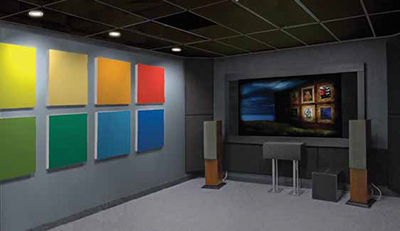Whether projects require absorbers, reflectors, and/or diffusers, the subject of acoustic treatment now arises early in the integration conversation.The speed of sound is no joke—no matter what the frequency, those waves are streaking towards you at 768 miles per hour. When acoustic treatments are on hand to calm those sound waves, AV installations become more appealing places.
Tools of the acoustic treatment trade are becoming more important for AV integrators to get ahead of, as the marketplace becomes increasingly aware of their role in treating a room. Whether projects require absorbers (to attenuate sound), reflectors (redirect), and/or diffusers (uniformly distribute it), the subject of acoustic treatment now arises early in the integration conversation.
Eric Smith, president and founder of Auralex, noted, “More and more clients are becoming aware that they simply must address their spaces’ acoustical needs—both from a construction standpoint and from an ambient standpoint—if they are to reap the maximum benefit of their investment in AV equipment. Second, they are in some cases demanding greener solutions and ones that are as at-home in their living spaces and in their theaters. This is where many integrators miss opportunity: they focus only on the theater or media room environment, but neglect the rest of the living space.”
“I think we are finally beginning to notice a change with respect to acoustics whereby folks understand how important a role the acoustics in a room will play when it comes to intelligibility,” added Peter Janis, president of Primacoustics. “This is likely due to contractors advising their customers, magazines discussing the problems, and people going to overly loud restaurants and realizing that the problem exists.”
Growing awareness on the topic among clients appears to be healthy, with houses of worship, medical teleconferencing, call centers, open-office environments, home theaters, and educational spaces all being identified as areas of growth for acoustical treatment. But change hasn’t come easy here.
“The three challenges are misinformation, lack of awareness, and budgets,” Janis said. “Many think that upgrading the PA system will improve intelligibility, but when the echo lasts longer than two or three seconds, you are doomed. As for awareness, folks simply do not consider acoustics as a first option. Finally, most people shy away from acoustics as they fear the cost of covering all of the walls and ceilings with panels will be prohibitive—in most cases, 20 to 25 percent coverage will solve the problem and turn a bad room into a functional space. So the solution is actually quite affordable.”
By the time the need for acoustical treatment has emerged, however, timelines may be overextended and budgets could be tapped out. “Being out of time and out of money is not the best place to start, so we recommend starting with the acoustics first while in the design phase,” explained Ryan Larkin, sales and marketing coordinator for Acoustics First. “We have also found that clients are not always 100 percent sure what approach should be taken with their applications. The internet has become supersaturated with loads of information on the subject of acoustics—it has become very difficult for the consumer to distinguish fact from fiction. Misinformation could easily cause someone to squander a large amount of money on materials that either do not work properly for their application, or do not meet building code requirements.”
With the changing landscape comes new product focuses for manufacturers of acoustical solutions. An increasing emphasis on visual aesthetics is evident, for one, as well as customization. “We are developing new products that can be custom-tailored to meet consumer demand to include products that can be customized in the field and readily available for shipment,” Larkin confirmed. “Custom now seems to be the new product in most cases. However, providing customized product solutions tailored to each job requires additional time to process, due to the complexity of the product or simply reviewing long lists of sizes and drawings. Electronically, users can now submit to us their project details to receive a solution customtailored to their individual needs.”
Primacoustics points to its new “Paintables” series of acoustic panels as an example of a new product that links in with the new thinking. “Paintables ship in a white latex finish and can be painted on site,” said Janis. “This helps a lot when it comes to integrating acoustic panels into the decor. With the Paintables, the user can create dramatic visual effects or simply have the panels blend in with the surroundings. And since the panels are easily installed they can be done by the end user with just a bit of coaching by the contractor.”
Looks matter at Aurelex as well, which designed the ProGo portable absorber to appear upscale while soaking up sound in a variety of environments, including living spaces. Meanwhile, their patentpending SheetBlok-AF is an aesthetically pleasing sound barrier, providing a solution for both new construction and retrofits where ideal sound isolation was not achieved.
Acoustics First’s aforementioned flexibility comes from products like their PhaseFOAM and Tone Tile acoustical systems, both of which allow integrators to purchase materials in small quantities. That facilitates a purchase of only the exact amount of material needed, or of additional material as the budget or facility expands. “PhaseFOAM is an acoustical kit designed for small and private facilities,” Larkin said. “The material is packaged to lessen the ‘buy-in’ blow to your budget. A couple of kits will get you started for many applications including broadcast studios, recording facilities, home theaters, home listening and gaming, and more.
“Tone Tiles are a rigid fiberglass acoustical panel with a paintable covering allowing you either match or accentuate existing room décor,” he continued. “The smaller panel size also allows you to create your own design and work around existing obstacles on the walls.”
For contractors who stay on top of acoustical treatments, these components can be a cornerstone of an expanded practice—one that helps their clients to get where they want to go faster and more cost-effectively. “Fixing the acoustics in a room is generally a lot easier that putting up a sound system,” said Janis. “There are of course different degrees of performance, such as concert halls that require acousticians. But for the most part, applying 25 percent coverage to the available wall surfaces will solve 90 percent of the problems. And once you do your first installation, the rest become second nature.

The calming effects of acoustical treatment are put to the test in this Primacoustics install at a pet care facility.“The good news,” Janis added, “is that more and more contractors are specifying acoustics in their installations, as they know how much better the PA will sound if the room is treated. And when people visit properly-treated rooms they notice, ask about the installation, and the contractor gains more customers.”
Larkin advises AV designers and integrators to look ahead to what the room will sound like when the installation is completed. “Think ‘acoustics first’ and don’t get caught off guard when the sound system installation is complete,” he said. “No amount of electronic equipment or EQ can correct the physics of the room. We work with many integrators who include acoustics as part of the complete sound system package—these integrators know acoustical material should be included in the design phase.
“This tends to be a small portion of the overall budget,” he continued, “but goes a long way to improving the environment to ensure the sound system functions correctly. Therefore, the facility can be enjoyed for many years and proves to be a wise investment.”
While technical excellence is always the goal in AV installations, a well-honed acoustic environment has emotional advantages as well. Tame those speedof- sound waves, and a sense of wellbeing just may become an element of the install.
“We live in such a frazzled, hectic world, that I believe that what clients are seeking when they invest in equipment is really not just good sound or visuals, but an escape from their frantic lives,” Smith pointed out. “What integrators need to convey to clients is that there are myriad benefits from getting their spaces constructed and acoustically treated correctly, then outfitting the spaces to the best of the clients’ abilities. When one enters a well-done environment, be it a theater or recording studio, one can feel one’s blood pressure and cortisol level drop. To me, this is what we’re selling clients—not just the widgets.”
David Weiss (www.dwords.com) writes extensively about AV, audio, and broadcast technology.
Four New Places to Sell Acoustical Treatment
1 Boardroom/Meeting Rooms - the trend is very open concept with no absorption in the space whatsoever. The increase in conference calling and distance presentations is turning these facilities into mini broadcast centers.
2 Classrooms/Lecture Halls - Essex Study in England has piqued interest in acoustic treatment outside of music departments. There is a move away from carpeting and padded seating.
3 Office Spaces - Open concept offices create sound issues around privacy and focus/ productivity.
4 Restaurants - Allowing owner/operators to control the energy. Second most common complaint by patrons in restaurant business is volume, after poor service.
—James Wright, Primacoustic Business Development Canada
